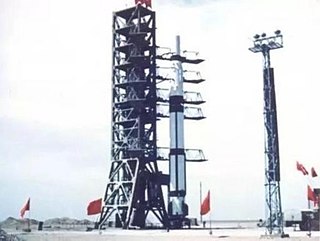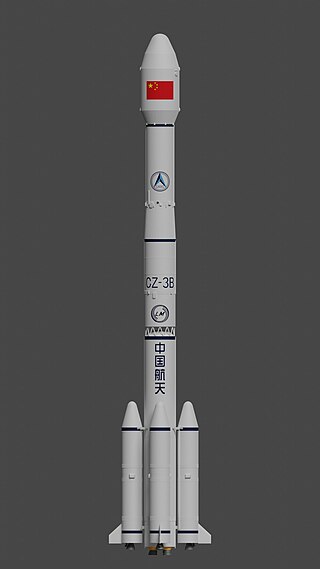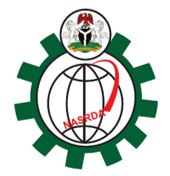The Long March rockets are a family of expendable launch system rockets operated by the China Aerospace Science and Technology Corporation. The rockets are named after the Chinese Red Army's 1934–35 Long March military retreat during the Chinese Civil War.

The space program of the People's Republic of China is about the activities in outer space conducted and directed by the People's Republic of China. The roots of the Chinese space program trace back to the 1950s, when, with the help of the newly allied Soviet Union, China began development of its first ballistic missile and rocket programs in response to the perceived American threats. Driven by the successes of Soviet Sputnik 1 and American Explorer 1 satellite launches in 1957 and 1958 respectively, China would launch its first satellite, Dong Fang Hong 1 in April 1970 aboard a Long March 1 rocket, making it the fifth nation to place a satellite in orbit.
Surrey Satellite Technology Ltd, or SSTL, is a company involved in the manufacture and operation of small satellites. A spin-off company of the University of Surrey, it is presently wholly owned by Airbus Defence and Space.
The Disaster Monitoring Constellation for International Imaging (DMCii) or just Disaster Monitoring Constellation (DMC) consists of a number of remote sensing satellites constructed by Surrey Satellite Technology Ltd (SSTL) and operated for the Algerian, Nigerian, Turkish, British and Chinese governments by DMC International Imaging. The DMC provides emergency Earth imaging for disaster relief under the International Charter for Space and Major Disasters, which the DMC formally joined in November 2005. Other DMC Earth imagery is used for a variety of civil applications by a variety of governments. Spare available imaging capacity is sold under contract.

The Space & Upper Atmosphere Research Commission, commonly referred to as SUPARCO, is an agency of the Government of Pakistan responsible for the national space program.
AsiaSat 1 was a Hong Kong communications satellite, which was owned, and was operated, by the Hong Kong based Asia Satellite Telecommunications Company. It was originally launched in February 1984 as Westar 6, but following a booster motor failure it was retrieved and returned to Earth in November of that year by Space Shuttle mission STS-51-A. After being sold to AsiaSat and refurbished, it was relaunched in April 1990, and positioned in geostationary orbit at a longitude of 100.5° East. It spent its operational life at 100.5° East, from where it was used to provide fixed satellite services, including broadcasting, audio and data transmission, to Asia and the Pacific Ocean.
NigComSat-1 was a Nigerian communication satellite. The initial contract to build the satellite was signed in 2004. It was launched in China by Nasrda and became the third African geosynchronous communication satellite, when it was launched at 16:01 UTC on 13 May 2007, aboard a Chinese Long March 3B carrier rocket, from the Xichang Satellite Launch Centre in China. The spacecraft was operated by Nigerian Communications Satellite Ltd (NIGCOMSAT). On November 11, 2008, NigComSat-1 failed in orbit after running out of power due to an anomaly in its solar array.
Nigerian Communications Satellite (NIGCOMSAT) Limited is a company under the supervision of the Federal Ministry of Communications and Digital Economy.
ChinaSat is the brand name of communications satellites operated by China Satellite Communications.

The Long March 3B, also known as the CZ-3B and LM-3B, is a Chinese orbital launch vehicle. Introduced in 1996, it is launched from Launch Area 2 and 3 at the Xichang Satellite Launch Center in Sichuan. A three-stage rocket with four strap-on liquid rocket boosters, it is the heaviest variant of the Long March 3 rocket family, and is mainly used to place communications satellites and navigation satellites into geosynchronous orbits.
Paksat-1R is a geosynchronous, communications satellite that was manufactured by China Great Wall Industry Corporation (CGWIC) and operated by the Space and Upper Atmosphere Research Commission (SUPARCO), an executive space authority of the Government of Pakistan.

The year 2011 saw a number of significant events in spaceflight, including the retirement of NASA's Space Shuttle after its final flight in July 2011, and the launch of China's first space station module, Tiangong-1, in September. A total of 84 orbital launches were conducted over the course of the year, of which 78 were successful. Russia, China and the United States conducted the majority of the year's orbital launches, with 35, 19 and 18 launches respectively; 2011 marked the first year that China conducted more successful launches than the United States. Seven crewed missions were launched into orbit during 2011, carrying a total of 28 astronauts to the International Space Station. Additionally, the Zenit-3F and Long March 2F/G carrier rockets made their maiden flights in 2011, while the Delta II Heavy made its last.
Sino Satellite Communications Co., Ltd. known also as SinoSat is a Chinese company.
Astronautic Technology Sdn Bhd or better known as ATSB was established on 1 May 1995 and is wholly owned by the Minister of Finance Inc under the supervision of the Malaysian Ministry of Energy, Science, Technology, Environment and Climate Change (MESTECC).
The Space Programme 2040 is a satellite development and launch programme of the Space and Upper Atmosphere Research Commission (Suparco), Pakistan's space research authority. The Space programme 2040 intends to replace the Badr satellite programme and geo-stationary communication satellite. On 11 August 2011, Paksat-IR was launched from Xichang Satellite Launch Center by China, making it first satellite to be launched under this programme. According to Suparco, five GEO satellites and six low Earth orbit (LEO) satellites will be launched between 2011 and 2040.

The Algerian Space Agency, was established on January 16, 2002 in Bouzareah, Algiers. The agency is in charge of the Algerian space program, and has flown five different satellites.

Planet Labs PBC is a publicly trading American Earth imaging company based in San Francisco, California. Their goal is to image the entirety of the Earth daily to monitor changes and pinpoint trends.
The National Space Program (PSN) horizons 2020 planned to put in place space infrastructures, space systems and increase the specialized human resources in space technologies. Among the space systems planned in the PSN are Algeria's satellites, of which a significant number should be partly or totally integrated in the Algerian center for satellite development "CDS". CDS offers the technological environment for national competence to develop the future Algerian satellite systems. Algeria's objectives is to make of space tools a powerful instrument in national prosperity in the fields of earth observation, meteorology and communications.

Nigeria EduSat-1 was a Nigerian nanosatellite built by the Federal University of Technology Akure (FUTA), created in conjunction with the Japanese Birds-1 program. It was Nigeria's first satellite built by a university. It was launched from the Japanese Kibō module of the International Space Station, being brought to the station as part of SpaceX CRS-11.
The domain of international space politics gained significant traction during the Cold War. This was largely fuelled by the ongoing space race between the USA and the USSR. At this time in history, space exploration was an endeavour largely restricted to the global superpowers and seemed out of reach for many smaller, developing, nations to actively participate in. Subsequently, public concerns for the cost of research and development into novel space technologies did not receive sufficient policy and academic attention in Africa. As the Cold War reached its conclusion, political power began to diffuse across the world, and this led to many smaller nation states developing national and regional space capabilities. In the context of Africa, Nigeria, Algeria, Egypt and South Africa were the front-runners in terms of investments into space-related research and development.









